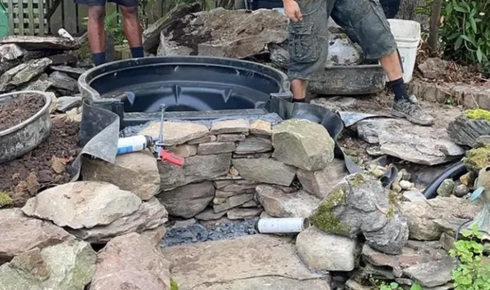There’s something almost magical about a backyard pond. The gentle ripple of water, the subtle reflection of sunlight on the surface, and the quiet presence of fish and plants—it creates a small sanctuary in the middle of a busy life. But anyone who’s owned a pond knows that achieving and maintaining that picture-perfect clarity takes more than occasional scooping of leaves. Water is a living, breathing ecosystem, and keeping it balanced requires attention, care, and, most importantly, the right filtration. This is where a pond water filtration system for home can transform your backyard from a messy water feature into a thriving oasis.
I remember when I first set up my pond. I stocked it with koi and added a few aquatic plants, thinking that would be enough to keep things neat. By mid-summer, the water had turned murky, algae had taken hold, and the fish looked less vibrant. A friend suggested installing a proper filtration system, and honestly, I was skeptical. But once I invested in a good setup, the difference was immediate. Water cleared, fish became more active, and even the smell of stagnant water disappeared. It was a small change with a massive impact.
Why Filtration Matters
A pond is more than just a decorative feature; it’s an ecosystem. Fish produce waste, plants shed leaves, and algae feed on nutrients in the water. Left unchecked, these elements accumulate, cloud the water, and disrupt oxygen levels, which can stress or even harm fish.
A high-quality pond water filtration system doesn’t just remove debris—it balances the ecosystem. Mechanical filtration captures floating particles and sediment, while biological filtration supports beneficial bacteria that break down harmful compounds like ammonia and nitrites. Together, these components maintain a healthy nitrogen cycle, keeping both water clarity and water chemistry in check.
Even if you aren’t using your pond for drinking, proper filtration ensures that it remains an inviting and safe environment for fish, plants, and wildlife. Algae growth is reduced, odors are minimized, and your pond looks and feels like a calm, natural retreat.
Types of Pond Filtration Systems
Not all filtration systems are created equal, and understanding your options can make a world of difference. Mechanical filters physically trap debris like leaves, twigs, and uneaten fish food. Biological filters, on the other hand, provide a home for bacteria that process waste into harmless compounds. Some advanced setups even include chemical or UV filtration to remove odors, discoloration, and harmful microorganisms.
For homeowners interested in versatile solutions, combining different filtration types can provide a balanced system that addresses multiple issues at once. For example, mechanical filters handle the obvious debris, biological media tackles hidden contaminants, and UV sterilizers keep algae under control. This combination ensures that your pond remains clean and clear without constant manual intervention.
Ensuring Safe Water for Consumption
While most backyard ponds aren’t designed as drinking water sources, some homeowners like to explore sustainable living options by creating safe water features. For these purposes, a specialized pond water filter for drinking is essential. These systems go beyond standard filtration by removing bacteria, protozoa, and sediment, ensuring that water meets higher safety standards.
Installing such a system requires careful planning. You need to consider water sources, flow rates, and the level of purification required. When done correctly, it allows for water that’s safe for irrigation, aquaponics, or even direct consumption in emergencies. It’s a way to make a pond more than ornamental—transforming it into a functional part of a sustainable household ecosystem.
Practical Tips for Maintaining Your Filtration System
Even the best filtration system won’t work optimally without routine maintenance. Neglecting upkeep can lead to clogged filters, reduced water flow, and imbalanced ecosystems. A few simple practices can make a huge difference:
- Check and Clean Mechanical Media Regularly – Remove trapped debris to maintain flow.
- Monitor Biological Media – Avoid washing it too aggressively to preserve beneficial bacteria.
- Adjust Flow Rates Seasonally – In colder months, flow may naturally slow; in warmer months, you may need to increase circulation.
- Skim Surface Debris Frequently – Leaves and floating algae can overwhelm your system if left unchecked.
- Test Water Quality Periodically – Monitor pH, ammonia, nitrites, and nitrates to keep the ecosystem healthy.
Following these practices, combined with the right filtration system, ensures your pond remains a thriving, self-sustaining environment.
Choosing the Right System for Your Home
Selecting a filtration system depends on pond size, fish population, and desired water clarity. Smaller ponds may only need a basic mechanical and biological filter, while larger or heavily stocked ponds benefit from multi-stage systems with UV sterilization.
A pond water filtration system for home should be tailored to your specific needs. For instance, if you have koi or other high-maintenance fish, your system needs to handle a higher waste load. For ornamental ponds with minimal fish, a simpler setup may suffice. Consulting with professionals or experienced pond owners can help you match the right system to your pond’s requirements.
Seasonal Considerations
Pond maintenance is not a one-size-fits-all scenario. Seasons affect water quality significantly. In autumn, falling leaves can overwhelm your system. Summer heat accelerates algae growth and increases oxygen demand. Winter can slow biological filtration and may require temporary adjustments or even partial shutdowns depending on your climate.
A flexible filtration system can adapt to these seasonal changes. For example, mechanical filters catch debris before it sinks in fall, while biological filters maintain water chemistry in summer. Adjusting your maintenance routine and flow rates accordingly ensures consistent water quality year-round.
Creating a Balanced Pond Ecosystem
Filtration is just one part of a healthy pond ecosystem. Aeration, proper plant density, and a balanced fish population all contribute to water clarity and overall health. By pairing these practices with a high-quality pond water filtration system, you create an environment where your pond largely takes care of itself.
Healthy ecosystems have fewer algae blooms, clearer water, and happier fish. Plants thrive without excessive nutrient buildup, and water remains safe and pleasant for all inhabitants. Over time, this balance reduces the need for chemical treatments and minimizes maintenance, allowing you to enjoy the tranquility of your pond rather than constantly battling murky water.
Final Thoughts
Owning a pond is a rewarding experience, but it requires thought, effort, and the right equipment. A properly chosen pond water filtration system for home, combined with routine maintenance and ecosystem management, transforms your pond into a crystal-clear, thriving oasis. For homeowners considering advanced options, adding a pond water filter for drinking ensures versatility, providing safe, clean water for various uses.
From sparkling water that showcases vibrant fish to a lush aquatic plant environment, filtration systems make a noticeable difference in both the appearance and health of your pond. Beyond aesthetics, they create stability in the ecosystem, reduce maintenance stress, and extend the life of your pond infrastructure.

